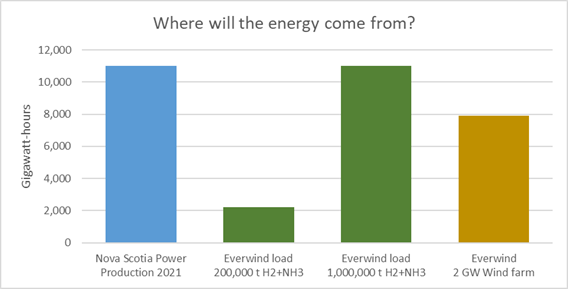Hydrogen's energy demand
Larry Hughes, PhD
Dalhousie University
Published: AllNovaScotia.com
17 February 2023

In Everwind's Approval Has Teeth, Halman Says (allnovascotia.com, 9 February), we are informed that "Using electrolysis, Everwind will consume vast amounts of electricity to split hydrogen and oxygen from the fresh water. The hydrogen gas will be converted into liquid ammonia..."
Since most of the electricity produced by Nova Scotia Power is sold to its customers, Nova Scotians need to know where these "vast amounts of electricity" will come from.
Green hydrogen is produced by electrolysis, a process which extracts hydrogen from water using electricity from renewable sources such as hydroelectricity and wind.
Shipping hydrogen gas over long distances is inefficient. A more widely used approach is to combine the hydrogen with nitrogen using the Haber-Bosch process to produce liquid ammonia for transport.
Creating green hydrogen and green ammonia is emissions-free but as the article indicates it is energy-intensive.
To produce a tonne of green ammonia and the green hydrogen it contains takes between 10 and 12 megawatt-hours of electricity. About 93% of this energy is required for the production of hydrogen.
The Everwind hydrogen-ammonia facility in Point Tupper plans to start exporting 200,000 tonnes of ammonia a year to Germany starting in 2025.
To do this, the project will require about 2.2 million megawatt-hours (or 2,200 gigawatt-hours) of electricity a year.
To put this number in perspective, in 2021, Nova Scotia Power produced slightly less than 11,000 gigawatt-hours of electricity and sold about 10,200 gigawatt-hours to its customers.
In other words, the electricity requirements of a 200,000-tonne green ammonia facility are about one-fifth of Nova Scotia Power's total production in 2021.
Which raises the question, where will the energy come from?
Everwind plans to build an onshore windfarm on crown land in Guysborough County.
Since turbine capacity is important, the windfarm could use turbines such as the GE-164 or the Vestas V162-6.2MW, which have capacities of slightly over six megawatts each.
If each turbine produces about 23.6 gigawatt-hours of electricity a year (assuming a 45% capacity factor), Everwind will require about 100 of these turbines.
Moving the electricity from the windfarm in Guysboro to Point Tupper will require the use of Nova Scotia Power's grid.
Everwind's Environmental Assessment for its 200,000 tonne hydrogen-ammonia facility just approved by Minister Halman, mentions in passing that the average daily power consumption from "Nova Scotia Power Grid" is estimated to be 4,500 to 5,000 MWh per day. This can increase to 8,400 MWh per day at "peak capacity".
Since wind is a variable resource, there will be times when the windfarm produces more electricity than the hydrogen-ammonia facility needs, and other times when it produces less.
If they have not already done so, Everwind and NSP will need the equivalent of a net-metering agreement, with NSP using the windfarm's excess electricity (or "spill") when it is producing more electricity than the facility needs and supplying the facility with electricity when there is insufficient electricity from the windfarm (or "topping up").
This could be a short-term issue if Everwind's two-gigawatt Guysborough windfarm project is completed over the next several years.
An onshore two-gigawatt wind farm could produce about 7,900 gigawatt-hours a year and would require about 330 of the six-megawatt GE or Vestas turbines.
However, even this excess will be short-lived.
By 2026, Everwind intends to export one million tonnes of ammonia to Europe. This will require about 11,000 gigawatt-hours of electricity a year.
This is as much electricity as Nova Scotia Power produced in 2021.

Where will Everwind get this electricity?
If the Labrador-Island Link ever lives up to its potential, 40% of the electricity from Muskrat Falls (about 1,800 gigawatt-hours) is to be sold as "market-priced" electricity.
There are five other wind farms the province approved last August which are expected to produce about 1,400 gigawatt-hours by 2025.
Electricity from these projects could meet some of Everwind's electricity needs.
However, it simply adds to Nova Scotia Power's problems, since Nova Scotia Power needs this electricity to phase-out coal so it can meet its 2030 emissions targets.
Last September, the province announced plans to offer leases for five gigawatts of offshore wind energy by 2030. The first call for bids will be in 2025, a year before Everwind plans to ramp up its ammonia production to one million tonnes a year.
In a media release at that time, Premier Houston said that, "Setting this [five gigawatt] target sends a clear signal to the world that Nova Scotia is open for business and becoming an international leader in offshore wind and green hydrogen development".
The premier's announcement failed to mention how his vision of Nova Scotia being a leader in green hydrogen will be integrated into the non-existent provincial energy strategy. Without that, the Everwind project risks becoming one of a historic string of expensive industrial project failures in the province.